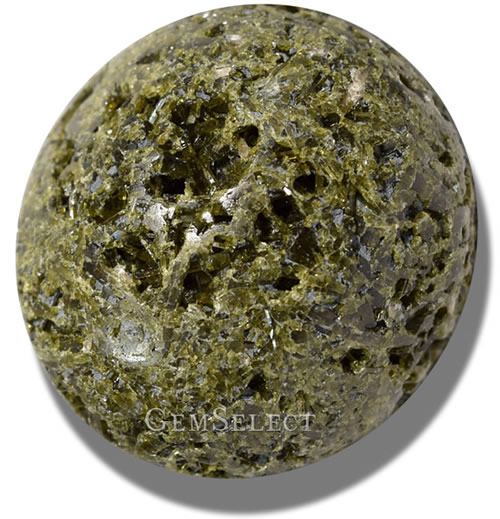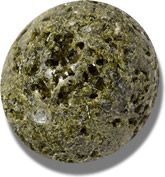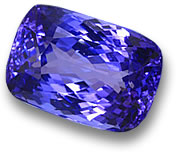Epidote Gemstone Information

About Epidote - History and Introduction
Epidote is actually a group of closely related minerals, but in the gem trade, the name typically refers only to the gem-quality green variety of the mineral epidote. The name 'epidote' is derived from the Greek word for 'addition' which refers to its numerous crystal faces. Although rarely of gem-quality and especially rare as a faceted gemstone, epidote is a commonly occurring mineral.
Epidote is a complex form of calcium aluminum iron silicate in which both calcium and aluminum ions are replaced by other metals such as manganese, ferric iron or yttrium and cerium metals. Since epidote is an alteration product, it has a wide variance in composition and chemical formula. Depending on the exact levels of iron, manganese and other substances, stones may be classified under various trade names or in many cases, as their own distinct mineral.
Clinozoisite is a white to pink colored form of epidote with a low iron content, resulting in a very a similar chemical composition to zoisite. Zoisite is best known for its violet-blue form known as tanzanite. Piemontite is a red manganese epidote typically occurring in an opaque form. Tawmawite is a chromium-rich dark green variety of epidote mined from Burma. Unakite is an altered form of granite with characteristic inclusions of epidote, often used in cabochon jewelry.
|
|

|
By chemical composition, epidote can be identified as a calcium aluminum iron silicate. It has a hardness of 6 to 7 on the Mohs scale, which makes it slightly softer than quartz; though it has poor toughness owing to its perfect basal cleavage. Epidote is strongly pleochroic, typically exhibiting varying greens, browns and yellows when viewed from different angles. Epidote has a high refractive index, similar to pyrope garnet. Epidote crystal formation is monoclinic and typically occurs in prismatic crystals; crystal twinning is common. Due to its rather high birefringence, identifying epidote is typically quite easy though proper testing. Some possibilities for confusion include similar green colored gemstones, such as idocrase (vesuvianite), chrome diopside and dravite tourmaline.
Epidote occurs in various geological environments, often forming in hornfels in contact metamorphic silicate rocks and in metamorphosed limestone. It is also found in igneous rock and occasionally forms in granite pegmatites.
Deposits of epidote are sourced from many locations around the world, including Australia, Austria, Brazil, China, Czechoslovakia, Finland, France, Italy, Japan, Kenya, Korea, Madagascar, Mexico, Mozambique, Myanmar (Burma), Norway, Switzerland, Sri Lanka (Ceylon) and the United States of America.
Buying Epidote and Determining Epidote Value Back to Top
Epidote Color
Epidote occurs in all shades and tones of green, with yellowish-green or pistachio color being most typical and most desirable. Colors can also include gray, brown and near-black. Epidote also exhibits a strong level of pleochroism, typically green, yellow and brown.
Epidote Clarity and Luster
Epidote can range in clarity from transparent to opaque; transparent crystals are the most valuable. Epidote takes an excellent polish and fine specimens can exhibit a bright and vitreous luster. Lower quality materials can have a slightly resinous luster when cut and polished.
Epidote Cut and Shape
The most desirable forms of epidote for collectors are elongated and extremely lustrous crystals, typically interconnected. Transparent and dark-green epidote is sometimes faceted for collectors, with the most popular shapes including traditional ovals, cushions or octagons. Other fancier shapes like trillions or hearts are quite rare. Opaque materials are often carved into ornamental objects. Careful orientation of cut is very important because of epidote's strongly pleochroic properties.
Epidote Treatment
Epidote is not typically treated or artificially enhanced in any way.
| Chemical Formula: |
Ca2(Fe,Al)3(SiO4)3(OH) - Calcium aluminum iron silicate |
| Crystal Structure: |
Monoclinic; prisms |
| Color: |
Pistachio green, yellowish green, blackish green |
| Hardness: |
6 to 7 on the Mohs scale |
| Refractive Index: |
1.729 to 1.768 |
| Density: |
3.0 to 3.50 |
| Cleavage: |
Perfect |
| Transparency: |
Transparent to opaque |
| Double Refraction or Birefringence: |
0.015 to -0.049 |
| Luster: |
Pearly, vitreous to resinous |
| Fluorescence: |
None |
Please refer to our Gemstone Glossary for details of gemology-related terms.
 |
| Tanzanite |
Epidote belongs to a group of related minerals. Actual epidote mineral is the most commonly known member of the epidote family. There are also several mineral associations of epidote, including quartz, calcite, garnet, albite, hornblende and apatite. Various other green gemstones can cause confusion, including vesuvianite (idocrase), dravite tourmaline, diopside and green garnet.
Epidote and clinozoisite are nearly identical and in many cases, a distinction cannot be made between the two minerals. In fact, many specimens are labeled as 'clinozoisite-epidote' since no determination can be made, or in some cases, a single crystal may even contain both minerals.
Most Popular Similar or Related Materials:
Clinozoisite, tanzanite, zoisite and ruby-zoisite are the most popular similar or related materials.
Lesser-Known Similar or Related Materials:
Hancockite, epidosite, thulite, anyolite, allanite, orthite, piemontite and tawmawite are the lesser-known similar or related materials.
Epidote Mythology, Metaphysical and Crystal Healing Properties Back to TopEpidote is a lesser-known gemstone and lacks much of the lore that many other popular gems have. It is not an official birthstone for any month and it has no significant role in the world of astrological gems. However, there are still a few metaphysical and crystal healing powers that are associated with this unique green gemstone.
Epidote is believed to be an 'attraction stone', which means whatever the wearer emanates is manifested or reciprocated. Epidote is considered to be a karma stone that will give or attract love if you bring or feel love, but the same quality applies to negative thoughts and qualities. When wearing epidote, be certain that you are ready to attract what you carry or 'reap what you sow'. Possess desirable thoughts rather than negative ones.
| Disclaimer: Metaphysical and Alternative Crystal Healing Powers and Properties are not to be taken as confirmed advice. Traditional, Ceremonial and Mythological Gemstone Lore is collected from various resources and does not represent the sole opinion of SETT Co., Ltd. This information is not to replace the advice of your doctor. Should you have any medical conditions, please see a licensed medical practitioner. GemSelect does not guarantee any claims or statements of healing or astrological birthstone powers and cannot be held liable under any circumstances. |
Epidote is not often used for jewelry due to the rarity of gem-quality materials and faceted gemstones. Mostly, epidote is faceted only for gemstone and mineral collectors' displays and showcases. Although it is considered hard enough to endure wear in 'protected' jewelry designs, such as earrings, pendants, pins or brooches, daily wear as rings or bracelets is not recommended as it can easily fracture and chip because of its perfect cleavage.
Note: Buy colored gemstones by size and not by carat weight. Colored stones vary in size-to-weight ratio. Some stones are larger and others are smaller than diamond by weight in comparison.
Epidote Gemstone and Jewelry Care and CleaningBack to Top Epidote is sensitive to extreme heat and vulnerable to partial decomposition by hydrochloric acid. Since it is quite fusible, avoid extreme heat and avoid cleaning it with harsh household chemicals. Epidote is not a tough material owing to poor basal cleavage. It is also softer than common quartz, and since ordinary dust often contains traces of quartz, simply wiping off dust can eventually lead to reduced polish and unwanted surface scratches. Epidote is sensitive to extreme heat and vulnerable to partial decomposition by hydrochloric acid. Since it is quite fusible, avoid extreme heat and avoid cleaning it with harsh household chemicals. Epidote is not a tough material owing to poor basal cleavage. It is also softer than common quartz, and since ordinary dust often contains traces of quartz, simply wiping off dust can eventually lead to reduced polish and unwanted surface scratches.
To clean your epidote, simply use soapy water and a soft cloth. Be sure to rinse well to remove soapy residue. As with most gemstones, ultrasonic cleaners and steamers are not recommended. Always remove any jewelry or gemstones before exercising, cleaning or engaging in harsh physical activities such as sports. Store epidote away from other gemstones to avoid scratches and fractures. It is best to wrap gemstones in soft cloth or place them inside a fabric-lined jewelry box.
|